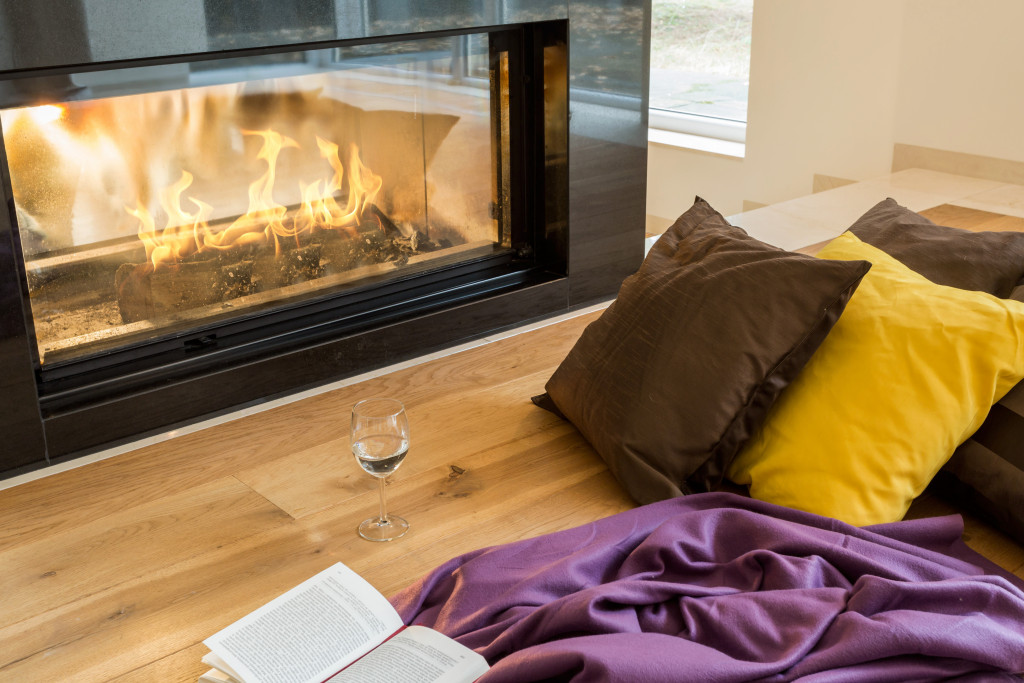- A cozy home in winter affects people’s mood, health, and productivity; maintaining heat is essential for home preservation.
- Optimal thermostat settings, sealing drafts, proper insulation, and fireplace inserts enhance energy efficiency.
- Balancing humidity levels prevents discomfort and safeguards health while avoiding mold growth.
- Adding elements like blankets, pillows, and plants makes your home inviting, promoting a positive winter experience.
Home comfort is vital, particularly during the harsh winter months. A cozy atmosphere contributes significantly to our overall well-being, affecting people’s mood, health, and productivity. Americans spend approximately 90% of their time indoors. This percentage may increase during the chilly winter when outdoor activities are limited. Moreover, a study published in the International Journal of Public Health shows that cold, damp homes can increase the risk of respiratory and cardiovascular diseases. Ensuring a warm, welcoming home environment during winter is, therefore, not just about comfort but also about safeguarding health.
However, it can be challenging to understand what to do when winter comes, especially when you are finally in charge of your home. Fortunately, these steps can guide you to maintain a cozy home during the cold months.
Keep the Heat On

Maintaining a warm interior environment is not just about comfort; it also significantly influences the physical state of your home. As the temperature outside dips, homes without adequate heating can experience problems such as frozen pipes and condensation, leading to dampness and mold. Furthermore, uneven or insufficient heating can cause wooden fixtures and furniture to contract and possibly crack. Keeping the heat on, therefore, is essential in preserving the structural integrity and general well-being of your home.
Adjust Your Thermostat Settings
Consider lowering your thermostat settings when you’re away from home, but avoid turning it off entirely. A good rule of thumb is to keep your home’s temperature at least 55°F to prevent pipes from freezing. You can also install a smart thermostat to adjust the temperature remotely or set a schedule for energy efficiency.
Seal Any Drafts
Drafty windows and doors can significantly affect your home’s heating, causing you to use more energy to keep it warm. Check for any drafts around windows and doors, and seal them with weatherstripping or caulking. You can also add insulation to attics, crawl spaces, and basements to prevent heat loss.
Install Fireplace Inserts
Some homeowners might rely on traditional fireplaces for warmth, but they are not always efficient in heating a home. Consider installing a conventional fireplace insert to improve energy efficiency and reduce heat loss through the chimney. The feature can be an aesthetic addition to your home while keeping you warm during the winter.
Add Proper Insulation
Proper insulation is essential in maintaining a cozy and comfortable home during the winter. Walls, attics, crawl spaces, and basements should be adequately insulated to prevent heat loss and keep your home warm. Consider using energy-efficient options such as spray foam insulation or cellulose insulation.
Maintain Humidity Levels

Maintaining the proper humidity levels at home during winter is crucial for comfort and health. When heating systems are turned on, the air inside the house can dry, causing discomfort and various health issues. Dry air can lead to dry skin, irritated nasal passages, and sore throats. It can also increase susceptibility to colds and respiratory infections. Moreover, it can cause harm to your home’s interior, leading to cracked furniture and peeling wallpaper.
To prevent these problems, consider using a humidifier to add moisture to the air. Ideal indoor humidity levels range between 30% to 50%. You can monitor this with a hygrometer or through smart home systems. Additionally, you can also naturally add humidity to the air through activities like air-drying your clothes inside or leaving water to boil on the stove. Remember that balancing humidity levels is a delicate game – too much humidity can lead to mold growth, so it’s essential to strike a balance to maintain a cozy home during the winter.
Make Your Home Inviting
Winter can feel long and dreary, but you can make your home a warm and inviting place to be. Add extra throw blankets, fluffy pillows, and soft rugs to create a cozy and comfortable living space. You can also decorate with warm colors like reds, oranges, and yellows to add warmth to your home’s ambiance.
Another tactic involves adding plants to your home. Not only do they add a touch of greenery, but they can also help purify the air while adding moisture and oxygen to your home’s atmosphere.
Final Thoughts
A cozy home during winter is not just about turning up the heat but also taking a holistic approach to ensure comfort and well-being. Following these steps, you can maintain a warm, welcoming home environment that keeps you healthy and happy throughout the cold months. Remember to regularly check your heating systems and insulation and adjust as needed. With these tips, you can enjoy a cozy and comfortable winter season in the comfort of your home.
